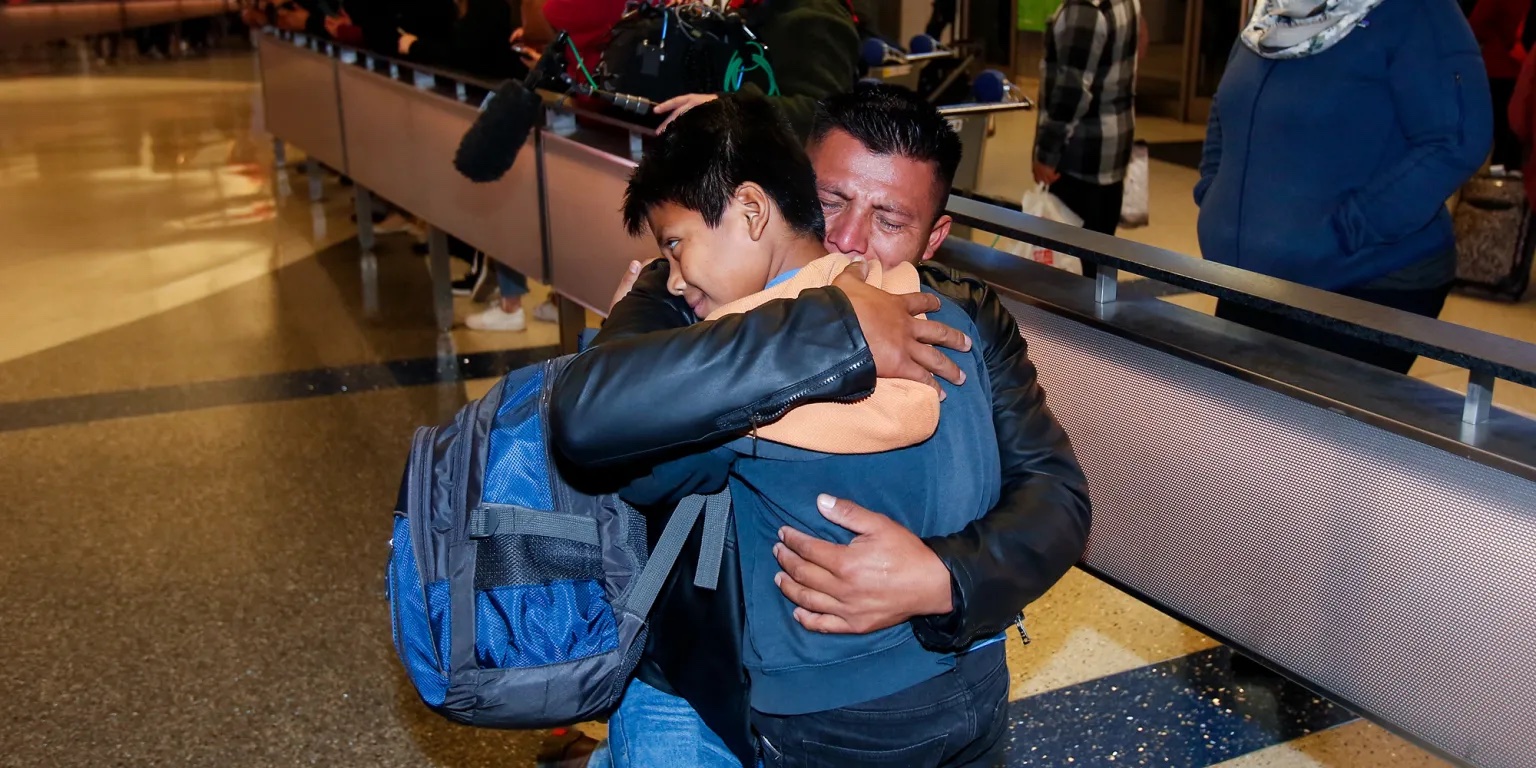Molly Baker, Associate Member, Immigration and Human Rights Law Review

I. Introduction
Between March 2017 and the end of 2019, U.S. Border Patrol (USBP) officials forcibly separated an estimated 4,656 immigrant children from their parents along the U.S.-Mexico border.[1] These forcible family separations were the result of a policy that President Trump’s first administration put in place in early 2017, which was officially named “Zero Tolerance.”[2] Part II explores the policies and procedures by which U.S. officials forcibly separated immigrant families. Part III dissects the impact of forcible family separation, opportunities for redress for affected families, and continuing reunification efforts. Finally, Part IV concludes by emphasizing why, especially amidst a changing immigration landscape in the United States, it is critical that the remaining separated children are reunified and that forcible family separations do not continue. This blog ultimately exposes how such forcible family separations constitute torture and enforced disappearance, both of which violate several basic human rights.
II. Background
Former Attorney General Jeff Sessions created the Zero Tolerance program to ensure that every adult who entered the United States without proper documentation would face prosecution.[3] Such prosecution came in the form of an “improper entry” charge, which was a minor federal criminal charge used during the Zero Tolerance program as a way to force parents away from their children.[4] If immigrant parents received an improper entry charge, they would temporarily lose custody of their children as a means of punishing and discouraging immigration.[5]
This is not the first time USBP used improper entry charges to enforce immigration laws.[6] However, before 2017, the U.S. Department of Homeland Security (DHS) generally did not request the prosecution of parents arriving with children, and federal prosecutors typically did not pursue improper entry charges against parents traveling with their children.[7] Despite attempts to blame the Obama administration for instituting forcible family separation policies, it was not until the Trump administration that the separation of immigrant children from their parents became common.[8]
USBP’s rampant use of improper entry charges to enforce the Zero Tolerance directive constituted forcible family separation.[9] Forcible family separation occurs when children are separated from their families without planning for or putting measures in place to enable reunification.[10] After separating children from their parents, DHS transferred the children to the Office of Refugee Resettlement (ORR) without putting measures in place that would allow authorities to reunite children with their parents.[11] ORR is an agency of the U.S. Department of Health and Human Services that is generally responsible for the care of unaccompanied migrant children.[12] Many of the children separated during the Zero Tolerance program were held at a border station for weeks in overcrowded and hazardous conditions.[13] Some children were forced to sleep on tile floors or shared sleeping mats with several other children.[14] Many went several days without showering or changing clothes.[15] Despite that it is often in the children’s best interest to keep families together, forcible family separations remained the status quo throughout the Zero Tolerance directive.[16]
During this time, government officials often refused to disclose the whereabouts of children to their parents for days or weeks, constituting enforced disappearances.[17] According to the United Nations Declaration on the Protection of All Persons from Enforced Disappearance, an enforced disappearance occurs when “persons are arrested, detained or abducted against their will or otherwise deprived of their liberty by officials…of Government…followed by a refusal to disclose the fate or whereabouts of the persons concerned or a refusal to acknowledge the deprivation of their liberty.”[18] Forcible family separations constitute enforced disappearances because children are separated from their families against the parent or child’s will, and parents are given little to no information on the whereabouts or wellbeing of their child.[19] According to the International Convention for the Protection of All Persons from Enforced Disappearance, it is a human right to know the truth regarding the circumstances of a disappearance, which parents and children involved in forcible family separations were systematically denied.[20] Additionally, the United States intentionally denied this right as immigration officials kept no organized records of the children that had been separated from their families.[21]
Forcible family separations also constitute torture, which is defined as the intentional infliction of severe pain or suffering for an improper purpose by a state agent.[22] Enforced disappearances violate human rights such as the right to recognition as a person before the law, the right to liberty and security of the person, and the right to know the truth regarding the circumstances of a disappearance.[23] As forcible family separations constitute torture, these actions also violate the human right not to be subjected to torture and other cruel, inhuman, or degrading treatment or punishment.[24] These enforced disappearances uniquely impacted entire families because parents and other family members did not have information about where their children were located or the nature of their care. Additionally, the children, some as young as three years old, were deprived of their parents in an entirely new environment and without a clear timeline of how and when they could expect reunification.[25]
A child’s physical and psychological response to the stress of forcible separation from their family can result in trauma that stays with them for their entire lives.[26] A child who lives with elevated stress levels for an extended period of time can experience lasting complications on their physical and mental health.[27] Studies show that children separated from parents in the first two years of life score significantly lower on IQ tests later in life.[28] Additionally, their fight or flight response system can become irreparably broken because they do not respond to stressful situations that would typically illicit physiological responses in other people.[29] Such an inability to differentiate and react to safe and dangerous situations accordingly can led to post-traumatic stress disorder.[30] Separated children also exhibit a regression in age-appropriate behaviors and often fail to meet developmental milestones.[31] Clinicians also reported that separated families, not only children, experience depression, overwhelming anxiety, and panic.[32] Despite the extensive negative impacts of forcible family separation, the Zero Tolerance policy continued.
Large-scale forcible family separations under the Zero Tolerance policy continued through the end of 2019.[33] In February of 2021, the Biden administration established the Family Reunification Task Force to reunite forcibly separated families.[34] Although 3,225 children were reunited with their parents, more than 1,300 children remain unaccounted for.[35] Unfortunately, forcible family separations still occur at the U.S.-Mexico border for reasons unrelated to the Zero Tolerance policy and illegal entry charges, including pregnant women separated from their partners and young adult children separated from their parents.[36] Despite the more than 1,300 children still waiting to be reunited with their families, the second Trump administration rescinded the executive order that created the Interagency Task Force on the Reunification of Families put in place by the Biden administration in 2021.[37]
III. Discussion
The path forward in the wake of thousands of forcible family separations is precarious. Many families sought redress for the damages they incurred as a result of their family separation. Although several families did not receive any sort of redress, others found relief under a settlement against U.S. Immigration and Customs Enforcement (ICE) or the Federal Tort Claims Acts (FTCA). Ultimately, the reunification of the children still separated from their families remains uncertain as there is no clear method or initiative for reunification.
A. Redress for Separated Families and Accountability
To hold ICE accountable, enact change, and provide redress to families separated under the Zero Tolerance policy, the American Civil Liberties Union brought a lawsuit against ICE on behalf of several families, known as the Ms. L case.[38] As a result of the case, the U.S. District Court for the Southern District of California granted an injunction against systematic family separations, and ordered the location and reunification of separated children.[39] The eventual settlement agreement in the Ms. L case also provided six months of housing support, immigration legal assistance, and medical services to separated families.[40] However, parole and work authorization under the settlement were limited to thirty-six months.[41] An additional 940 families sued the government under the FTCA for the harms they experienced during and as a result of family separation.[42] However, it is difficult for many families to devote the time and financial commitment required to pursue what oftentimes is years-long litigation.[43] Additionally, only some of these cases were successful due to general limitations of the FTCA.[44] Even if a family won their suit, the only available remedy is monetary compensation, and the monetary damages awarded were limited.[45] Lastly, the FTCA imposed a two-year statute of limitations that many families missed because they were not aware or informed of their rights.[46] This limited opportunity for any redress, especially adequate redress, likely violates the human right to an effective remedy, protected by the Universal Declaration of Human Rights.[47] The right to an effective remedy specifically includes the victim’s right to “equal and effective access to justice; adequate, effective, and prompt reparation for harm suffered; and access to relevant information concerning violations and reparation mechanisms.”[48] Unfortunately, the relief offered by the Ms. L settlement and the FTCA do not meet the standard of an effective remedy for all affected families.
Finally, another path to redress could be under the federal criminal charge of conspiracy to deprive people of their rights.[49] This federal statute does not require an underlying criminal offense, it solely criminalizes the conspiracy to infringe a right secured by federal law.[50] The Criminal Section of the U.S. Department of Justice’s Civil Rights Division should investigate whether the officials responsible for forcible family separation and Zero Tolerance conspired to interfere with the right to seek asylum, the right to family integrity, or other federal or constitutionally protected rights.[51] Not only must the federal government hold the appropriate officials accountable for the forcible family separations during Zero Tolerance, but efforts to reunify separated families must also be a top priority.
B. Continuing Reunification Efforts
In response to the Zero Tolerance policy, the U.N. Human Rights Committee recommended that the United States redouble their efforts to reunite all separated children with their families, guarantee that family separations are prohibited, ensure victims have access to effective remedies, and receive full reparations, including compensation and support services.[52] The Committee recommended such remedies as legal, medical, financial, and psychological assistance, including access to accommodations, shelters, and other support services.[53] Despite these recommendations, forcible family separations still occur at the U.S.-Mexico border.[54] Although the Ms. L case limited family separation, the practice may still be permitted for public safety or national security reasons, concerns for a child’s safety, medical care, or the prosecution of a parent for a felony.[55] Additionally, the limits on future family separation are only in place until 2031.[56] Although there are certainly situations in which family separation is unavoidable, the previous behavior of DHS officials in creating charges to separate families does not instill confidence that immigration agencies will refrain from finding other creative ways to inflict harm on immigrant families.
How can the United States continue working on reunification efforts for the more than 1,300 children who remain separated from their parents? One possible solution is genetic testing.[57] Yet, genetic testing to establish paternity presents serious privacy and consent concerns.[58] Genetic testing in the context of reunited separated families would include a standard paternity test with a saliva swab to confirm the identity of the parent and child.[59] Many children cannot give proper informed consent as they may be unable to fully understand the extent of the procedure to which they are consenting.[60] Additionally, in the unique situation of children separated from their families, their parents cannot consent on their behalf.[61] Expanding legislation to protect the genetic data itself, rather than the entities who possess that data, could ease the ethical issues.[62] For these reasons, genetic testing does not currently offer a proper solution for separated children.
IV. Conclusion
Forcible family separations at the U.S.-Mexico border violate several basic human rights. Specifically, USBP’s use of improper entry charges to forcibly separate immigrant families during Zero Tolerance amounted to enforced disappearance and torture. Unfortunately, the path toward redress for separated families is complicated and not all affected families can achieve such relief. However, arguably the most important component of this issue is the fact that over 1,300 children remain separated from their families and there is not currently a clear plan to reunify. The government officials responsible for these separations must be held accountable.
The path forward for children still awaiting reunification is unclear, but it is likely that they will remain in a prolonged state of limbo in the child welfare system without any connection to family or access to the now-dismantled reunification taskforce or legal aid. Considering the extensive physical and psychological effects of forcible family separation, it is imperative that the current administration prioritizes reunification for children who remain separated from their families. As the second Trump administration is still in its infancy, it is unclear whether a policy like Zero Tolerance will go into effect again; however, the executive order rescinding the Interagency Task Force on the Reunification of Families may be a sign of continued human rights violations for immigrants.
[1] We Need to Take Away Children, Hum. Rts. Watch (Dec. 16, 2024), https://www.hrw.org/report/2024/12/16/we-need-take-away-children/zero-accountability-six-years-after-zero-tolerance#8004 [https://perma.cc/G8ZD-8XAL].
[2] Id.
[3] Id.
[4] Id.
[5] Id.
[6] Id.
[7] Id.
[8] U.S. Border: Who Decided to Separate Children?, BBC (Jun. 26, 2019), https://www.bbc.com/news/world-us-canada-44303556 [https://perma.cc/N8XH-YK79].
[9] We Need to Take Away Children, supra note 1.
[10] Id.
[11] Id.
[12] Id.
[13] Id.
[14] Id.
[15] Id.
[16] Id.
[17] Id.
[18] G.A. Res. 47/133, U.N. Declaration on the Protection of All Persons from Enforced Disappearance (Dec. 18, 1992).
[19] We Need to Take Away Children, supra note 1.
[20] International Convention for the Protection of All Persons from Enforced Disappearance, Dec. 20, 2006, 2716 U.N.T.S. 3.
[21] We Need to Take Away Children, supra note 1.
[22] International Day of the Victims of Enforced Disappearances, 30 August, U.N., https://www.un.org/en/observances/victims-enforced-disappearance [https://perma.cc/SP9B-MHQ2] (last visited Feb. 11, 2025).
[23] Id.
[24] Id.
[25] Id.
[26] Thameshwarie Ghamandi, The Effects of Forcible Separation and the Ramifications Involved in Using Genetic Testing to Reunite Immigrants at the Border, 7 Child & Family L. J. 135, 140 (2019).
[27] Id.
[28] Id.
[29] Id.
[30] Id.
[31] John Washington, Family Separation at the Border Constitute Torture, New Report Claims, The Intercept (Feb. 25, 2020, 6:00am), https://theintercept.com/2020/02/25/family-separations-border-torture-report/ [https://perma.cc/J26G-MPVY].
[32] Id.
[33] We Need to Take Away Children, supra note 1.
[34] Id.
[35] Id.
[36] Hayley Burgess, Family Separation Persists at the U.S.-Mexico Border, UCLA Ctr. for Immigr. L. and Pol’y (June 20, 2024), https://law.ucla.edu/news/new-report-family-separation-persists-us-mexico-border [https://perma.cc/H6RQ-JV94].
[37] Exec. Order No. 14148, 90 Fed. Reg. 8237 (Jan. 20, 2025).
[38] Settlement Agreement, Ms. L., et al., v. U.S. Immigration and Customs Enforcement, et al., 310 F. Supp 3d 1133 (S.D. Cal. 2018), (No. 18-cv-00428).
[39] Id. at 5.
[40] Id. at 9.
[41] Id. at 15.
[42] We Need to Take Away Children, supra note 1.
[43] Id.
[44] Id.
[45] Id.
[46] Id.
[47] G.A. Res. 217 (III) A, Universal Declaration of Human Rights (Dec. 10, 1948).
[48] G.A. Res. 60/147 (Dec. 16, 2005).
[49] We Need to Take Away Children, supra note 1; See 18 U.S.C.S. § 242.
[50] Id.
[51] Id.
[52] U.N. HRC, 139th Sess., 4067th mtg., U.N. Doc. CCPR/C/USA/CO/5 (Dec. 7, 2023).
[53] Id.
[54] Burgess, supra note 36.
[55] Settlement Agreement, supra note 38, at 7.
[56] Id.
[57] Ghamandi, supra note 26, at 142.
[58] Id.
[59] Id. at 139.
[60] Id.
[61] Id.
[62] Id.


